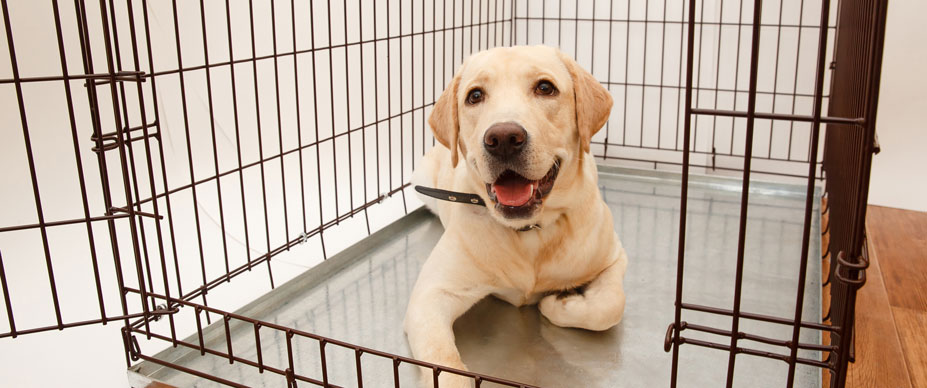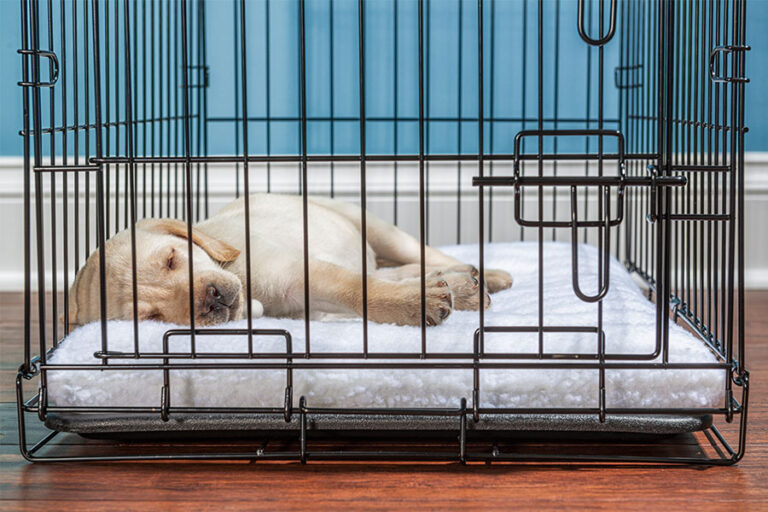A dog can be in a crate for up to 4-6 hours at a time, depending on its age and needs. It’s important to give the dog regular breaks for exercise and bathroom breaks.
Dogs can benefit from crate training to provide a safe and secure space, but it’s important not to leave them in the crate for extended periods. Puppies and senior dogs have shorter bladder control, so they shouldn’t be in a crate for more than a few hours at a time.
Proper crate training and regular breaks can help prevent anxiety and stress for the dog. By gradually increasing the time spent in the crate, the dog can become comfortable with longer periods. Understanding the dog’s needs and providing appropriate breaks is essential for their well-being.
Basics Of Crate Training For Dogs
Importance of crate training: Crate training is an essential part of raising a dog as it provides a safe and secure space for them. It helps in toilet training, avoids destructive behavior, and reduces anxiety.
Establishing a positive crate experience: Introducing the crate as a positive space by rewarding the dog for going inside and making it comfortable with bedding and toys is crucial. Gradually increasing the time spent inside the crate creates a positive association.
Types Of Crates
Choosing the Right Size is essential when it comes to selecting a crate for your dog. The crate should provide enough space for your dog to stand up, turn around, and lie down comfortably. If the crate is too big, the dog may use one end as a bathroom and the other for sleeping. On the other hand, a crate that is too small can cause discomfort and stress. It is important to measure your dog and choose a crate that will accommodate its size as it grows.
Wire crates vs. plastic carriers each have their own advantages. While wire crates provide better ventilation and visibility, plastic carriers offer more privacy and security for the dog. They are also easier to clean and can be more portable. The choice between the two largely depends on the specific needs of the dog and the owner’s preferences.
Assessing Individual Dog Needs
When assessing how long a dog can be in a crate, it’s important to consider individual needs. Recognizing breed-specific crate time limits is crucial. Additionally, taking into account age and activity level is vital. Different breeds have varying requirements for crate time, based on their size, energy levels, and temperament. Puppies generally have shorter crate time limits due to their higher energy and need for frequent potty breaks. Likewise, highly active breeds may require more frequent breaks out of the crate. It’s essential to observe and understand your dog’s behavior to gauge their comfort and well-being when spending time in a crate. By paying attention to these factors, you can ensure that your dog’s time in a crate is both safe and comfortable.

Credit: www.fourpaws.com
Setting A Crate Schedule
For puppies, the general guideline is that they should not be in a crate for more than 30 minutes to an hour. Adult dogs can generally handle a longer period, but it’s still important to ensure that they are getting enough exercise and interaction outside of the crate. Balancing crate time with physical activity and mental stimulation is crucial for the well-being of your dog. It’s important to gradually build up the time your dog spends in the crate and provide them with opportunities for play and socialization. Keeping to a consistent schedule and providing appropriate toys and positive reinforcement can help make crate time a positive experience.
Crate Time And Dog Wellbeing
How Long Can a Dog Be in a Crate
When it comes to crate time and dog wellbeing, it’s important to be mindful of \ signs of excessive crate time. Look out for indicators such as constant whining, barking, or destructive behavior. Additionally, pay attention to ensuring mental and physical stimulation. This can be achieved through interactive toys, puzzles, and regular playtime. Moreover, rotating the toys to keep things fresh and exciting can play a role in keeping your dog engaged and happy. In addition, a routine of regular walks or engaging in physical activities is essential for your dog’s wellbeing. By providing adequate mental and physical stimulation, you can help prevent negative behaviors and ensure your dog’s overall happiness.
The Incremental Approach
When crate training your dog, it’s essential to gradually increase the time they spend in the crate. Start with short intervals and monitor your dog’s response closely. This will allow you to adjust the crate time according to your dog’s comfort level and behavior. Always consider your dog’s well-being and make necessary changes to the crate time based on their reactions.
Balancing Crate Time With Activities
Dogs should not be in a crate for more than a few hours at a time. It is essential to balance crate time with regular breaks for walks, playtime, and training sessions. Integrating these activities ensures that dogs get the exercise, mental stimulation, and social interaction they need. Regular breaks from the crate are important for the overall well-being of the dog, helping to prevent boredom, anxiety, and restlessness. Providing a variety of activities during the day can help manage a dog’s energy levels and prevent behavioral issues related to confinement.
Creating A Comfortable Crate Environment
When it comes to creating a comfortable crate environment for your dog, investing in supportive bedding is essential. A good quality bed or cushion will provide comfort and support for your dog while they are in the crate. Additionally, providing toys and treats can help to make the crate a positive and enjoyable space for your dog. Toys can keep them entertained and mentally stimulated, while treats can create positive associations with being in the crate. It’s important to consider your dog’s individual needs and preferences when setting up their crate, as some dogs may prefer certain types of bedding or toys over others. By providing a comfortable environment with the right accessories, you can help ensure that your dog is happy and content while spending time in their crate.
Frequently Asked Questions Of How Long Can A Dog Be In A Crate
How Long Can A Dog Safely Stay In A Crate?
Dogs can be in a crate for 4-6 hours at a time. Puppies need shorter intervals. Limit crate time to prevent stress and discomfort.
How Do I Ensure My Dog Is Comfortable In The Crate?
Introduce the crate as a positive space. Leave the door open and provide comfort items, like toys or a cozy blanket.
Can Crating A Dog For Too Long Be Harmful?
Extended crate time can lead to stress, anxiety, and even physical health issues for dogs. It’s crucial to balance crate use with exercise and interaction.
Conclusion
The length of time a dog can safely spend in a crate depends on various factors such as age, breed, and individual needs. It’s essential to provide regular breaks and socialization to ensure their well-being. By understanding the importance of crate training and balancing it with out-of-crate time, you can create a comfortable and safe environment for your furry friend.



